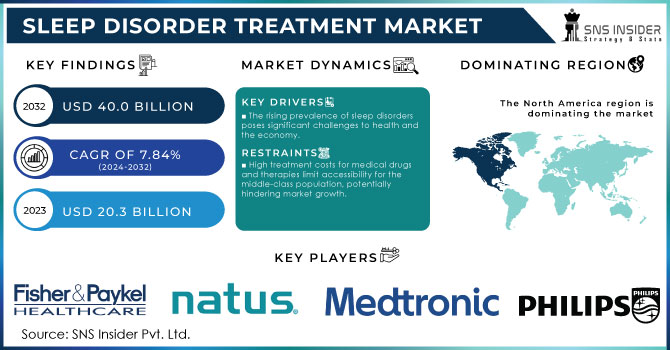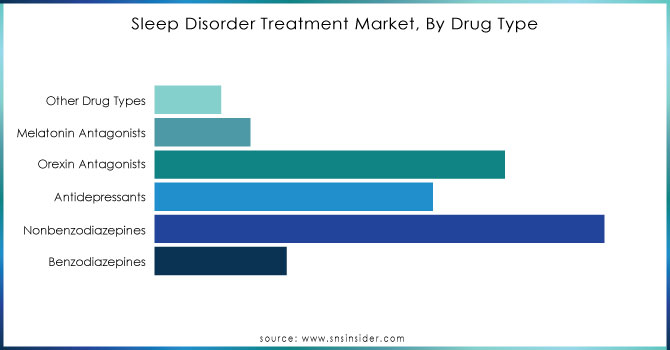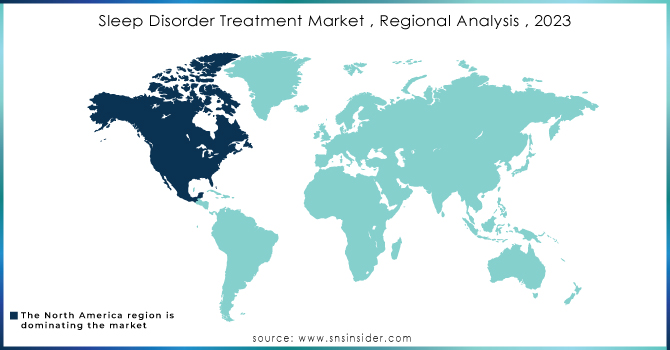Sleep Disorder Treatment Market Size & Overview:

Get more information on Sleep Disorder Treatment Market - Request Free Sample Report
The Sleep Disorder Treatment Market Size was valued at USD 20.3 Billion in 2023 and is expected to reach USD 40.0 Billion by 2032 and grow at a CAGR of 7.84% over the forecast period 2024-2032.
The sleep disorder treatment market is growing at a rapid pace. The factor facilitating this growth in the market is the increasing prevalence of sleep apnea, the rise in the geriatric population, and a growing awareness of sleep disorders among the general public, especially in developing countries. It is noted that the risk for sleep disorders is much higher among the aged and older adults have high susceptibility to conditions such as insomnia and sleep apnea. According to the latest Helsestart data, it appears that half of U.S. adults suffer from sleeplessness at least once a month, while 59% of adults in all Western countries report some type of insomnia throughout their lifetime. Cautionary warning: Japan, Taiwan, and Sweden topped the list for reported efforts at combating insomnia, while Norway does the most searching for melatonin.
Sleep Disorder Treatment Methods Overview:
| Treatment Category | Description | Common Applications | Advantages |
|---|---|---|---|
| Cognitive Behavioral Therapy | Psychological therapy aimed at improving sleep hygiene | Insomnia | Non-invasive, long-term efficacy |
| Continuous Positive Airway Pressure (CPAP) | A device that provides continuous air pressure | Sleep Apnea | Effective for moderate to severe apnea |
| Medications | Prescription drugs (e.g., sedatives, stimulants, melatonin) | Insomnia, Narcolepsy | Immediate relief, a variety of options |
| Lifestyle & Behavioral Changes | Sleep hygiene, stress management, exercise, diet modification | All sleep disorders | No side effects, holistic benefits |
| Surgical Procedures | Invasive methods like UPPP (Uvulopalatopharyngoplasty) | Severe Sleep Apnea | The long-term solution for structural issues |
With this growing awareness of sleep disorders, there is now a rising tide of patients coming out seeking their solution - insomnia, narcolepsy, and sleep without pattern among others. The governments are indeed becoming attuned to this matter, and they are taking action to curb the rising incidence of sleep disorders, which anyway is associated with other mental health disorders like anxiety, depression, and post-traumatic stress disorder. Second, treatment technologies are emerging in the market with recent innovations in continuous positive airway pressure (CPAP) therapy. For example, as happened recently, new approvals for drugs, such as those related to Idorsia's Quviviq for insomnia in January 2022, illustrate a huge potential in this market, much like that relating to the more recent approval JAZZ Pharmaceuticals took on Xywav for idiopathic hypersomnia.
The rapidly growing trend of telemedicine is helping patients receive sleep disorder treatments from their bedroom comfort. This trend is further increasing the demand for diagnostics and therapeutics in addition to the rising levels of insurance coverage for sleep disorder treatments. Sleep Disorders Estimated 50 million to 70 million people suffer from sleep disorders in the United States according to the American Sleep Association, and this is a mammoth problem that needs urgent solutions.
Yet, the market still sees pressures from several quarters, especially in strict regulatory frameworks for governance that regulate the diagnosis and therapy apparatuses for sleep disorders. They fall under Class II, by the FDA, which has broad preclinical and clinical tests to undertake before getting any approval to sell in the market. Despite all these considerations, the overall market prospect is encouraging, mainly with growing awareness and developing treatment options.
Regional Distribution of Sleep Disorder Treatment Adoption:
| Region | Common Sleep Disorders | Adopted Treatments | Government Initiatives |
|---|---|---|---|
| North America | Sleep Apnea, Insomnia | CPAP Devices, Medications | Public health campaigns, reimbursement policies |
| Europe | Insomnia, Restless Leg Syndrome | Behavioral Therapy, Medications | National health insurance coverage |
| Asia-Pacific | Sleep Apnea, Insomnia | CPAP Devices, Herbal Supplements | Increased focus on mental health |
| Latin America | Narcolepsy, Insomnia | Medications, Lifestyle Changes | Limited access to advanced treatments |
| Middle East & Africa | Sleep Apnea, Insomnia | CPAP Devices, Behavioral Therapy | Rising awareness and healthcare investment |
Sleep Disorder Treatment Market Dynamics
Drivers
-
The rising prevalence of sleep disorders poses significant challenges to health and the economy.
Recent studies have established that the prevalence of sleep disorders is increasing to the extent that between 50 to 70 million adults are affected. Such increases in medical conditions are said to be influenced by lifestyle and technological advancement, including sleep apnea, insomnia, and restless legs syndrome (RLS). Around 30 percent of the adult population globally suffers from insomnia, while environmental factors such as noise and light pollution worsen the problem. Urbanization and loss of biodiversity are some of the major causes behind it. As sleep disorders increase in numbers, the business prospects of the providers of healthcare services and medical device manufacturers will also rise, which will gradually benefit the global sleep disorder treatment market.
This has led to increased awareness among healthcare professionals, organizations, and governments on sleep disorders and their health-related adverse implications, thus spreading education. With sleep disorders, it is not only the health aspect that is hit but also the economy because it contributes to the decline in productivity in various sectors. Increased awareness of how a sleep disorder could have a direct impact on one's life makes the patient seek treatment at an early stage; such increased demand will propel the growth of the sleep disorder treatment market among various healthcare service providers.
Restraints
-
High treatment costs for medical drugs and therapies limit accessibility for the middle-class population, potentially hindering market growth.
-
Technological advancements in developed regions are often accompanied by increased expenses, making treatments less affordable.
-
Insufficient inclusion of sleep disorder treatments in health insurance policies may restrict the number of patients seeking necessary care.
Sleep Disorder Treatment Market - Key Segmentation
By Drug Type
In 2023, nonbenzodiazepines were the largest drug category in the sleep disorder treatment market, accounting for around 35.0% of its total share. They are more sought after than other drugs, primarily benzodiazepines, because of their efficacy in promoting sleep with significantly lower reactivity to dependency, such as that associated with benzodiazepines, in drugs like Zolpidem and Eszopiclone. Due to a favorable side-effect profile and swift onset of action, these drugs are becoming increasingly popular among healthcare providers and patients who require relief from insomnia and other sleep disorders. As awareness continues to increase regarding the dangers of long-term use of traditional benzodiazepines, demand for nonbenzodiazepines should continue to grow.
The orexin antagonist is the drug type that is growing the fastest since it is expected to grow more than 12% during the forecast period. The medication lemborexant and others were shown effective in the treatment of insomnia, acting via blockade of the orexin system, which is the key mediator of wakefulness. Their novel mechanism of action and lower risk for residual daytime sedation make orexin antagonists a tempting alternative for patients and trigger their rapid expansion in the market.

Need any customization research on Sleep Disorder Treatment Market - Enquiry Now
By Application
The sleep disorder treatment market was dominated by the insomnia segment in 2023, holding approximately 40.0% of its share. The high prevalence of insomnia due to rising factors like stress, changes in lifestyle, and awareness about the disorder is increasingly enhancing the demand for effective treatment and solutions among patients. Of late, people diagnosed with poor quality of sleep are increasingly seeking solutions through various therapeutic areas such as drugs, cognitive behavioral therapy, and lifestyle. This rising awareness of the impact of insomnia on health and lifestyle fuels the supremacy of the segment.
Application to sleep apnea is seeing the highest growth rate during the forecast period with a projected CAGR of about 10% during the next several years. The rising epidemiological rates, more so in the geriatric demographic and the comorbidities of obesity and hypertension, are fueling demand for treatment options. The growing awareness among patients about the health conditions related to sleep apnea, including cardiovascular and metabolic disorders, is increasing the demand for patients seeking diagnoses and treatments. Hence, this is driving the demand in the therapy area.
Sleep Disorder Treatment Market Regional Analysis
North America dominated the sleep disorder treatment market with a 46.8% share in the year 2023. This was mainly due to the increased prevalence of sleep disorders and awareness as well as a growing demand for treatments in the United States and Canada, combined with high healthcare expenditure in this region. These factors will drive market growth: favorable reimbursement policies for therapeutic products, a strong pipeline of clinical, and the growing level of stress in the population. Adults reported an average level of 5.0 out of 10 for the year 2020; Gen Z adults increased their level of stress to 6.1 for the same period according to this American Psychological Association survey.
According to the American Academy of Sleep Medicine, stress is identified as a trigger that causes adjustment insomnia that affects 20% of the U.S. population yearly, aside from other factors. Behavioral insomnia also describes children who fail to develop good sleep habits and is found in about 30% of the pediatric population. In 2021, nearly 51% of Americans reported using sleep aids during the COVID-19 pandemic, which indicates rising awareness of sleep medications among Americans. This increased awareness and usage of sleep treatment will further facilitate substantial growth in the market in the forecast period. Due to the rising level of awareness and the higher demand for effective treatments of sleep disorders, North America will remain a key geographical region for the growth of the market.

Key Players in the Sleep Disorder Treatment Market Based on Their Offerings
Sleep Apnea Devices
-
Fisher & Paykel Healthcare
-
ResMed Inc.
-
Philips Healthcare
-
Invacare Corporation
-
BMC Medical Co., Ltd
-
Inspire Medical Systems
Sleep Monitoring and Diagnostic Devices
-
Natus Medical Inc.
-
Nihon Kohden Corporation
-
Advanced Brain Monitoring
-
SleepMed Inc.
-
NovaSom, Inc.
Drug Therapies and Treatment Solutions
-
Medtronic plc
-
DeVilbiss Healthcare
-
Cardinal Health
Overall Healthcare and Medical Devices
-
Koninklijke Philips N.V.
-
Becton, Dickinson, and Company
Recent Developments
In June 2024, Recent research published in the New England Journal of Medicine highlighted the positive effects of tirzepatide in adults with obesity and moderate-to-severe obstructive sleep apnea (OSA). The study found that tirzepatide significantly decreased the apnea-hypopnea index (AHI), body weight, high-sensitivity C-reactive protein (hs-CRP) levels, hypoxic burden, and systolic blood pressure, while also enhancing patient-reported sleep-related outcomes compared to a placebo.
| Report Attributes | Details |
|---|---|
| Market Size in 2023 | USD 20.3 Billion |
| Market Size by 2032 | USD 40.0 Billion |
| CAGR | CAGR of 7.84% From 2024 to 2032 |
| Base Year | 2023 |
| Forecast Period | 2024-2032 |
| Historical Data | 2020-2022 |
| Report Scope & Coverage | Market Size, Segments Analysis, Competitive Landscape, Regional Analysis, DROC & SWOT Analysis, Forecast Outlook |
| Key Segments | • By Drug Type (Benzodiazepines, Nonbenzodiazepines, Antidepressants, Orexin Antagonists, Melatonin Antagonists, Other Drug Types) • By Application (Insomnia, Sleep Apnea, Narcolepsy, Circadian Disorders, Other Applications) |
| Regional Analysis/Coverage | North America (US, Canada, Mexico), Europe (Eastern Europe [Poland, Romania, Hungary, Turkey, Rest of Eastern Europe] Western Europe] Germany, France, UK, Italy, Spain, Netherlands, Switzerland, Austria, Rest of Western Europe]), Asia-Pacific (China, India, Japan, South Korea, Vietnam, Singapore, Australia, Rest of Asia-Pacific), Middle East & Africa (Middle East [UAE, Egypt, Saudi Arabia, Qatar, Rest of Middle East], Africa [Nigeria, South Africa, Rest of Africa], Latin America (Brazil, Argentina, Colombia, Rest of Latin America) |
| Company Profiles | Fisher & Paykel Healthcare, ResMed Inc., Philips Healthcare, Invacare Corporation, Teleflex Inc., BMC Medical Co., Ltd, Inspire Medical Systems, Natus Medical Inc., Nihon Kohden Corporation, Compumedics Limited, Advanced Brain Monitoring, SleepMed Inc., NovaSom, Inc., Medtronic plc, DeVilbiss Healthcare, Cardinal Health, Koninklijke Philips N.V., Itamar Medical Ltd., Becton, Dickinson, and Company |
| Key Drivers | • The rising prevalence of sleep disorders poses significant challenges to health and the economy. |
| Restraints | • High treatment costs for medical drugs and therapies limit accessibility for the middle-class population, potentially hindering market growth. • Technological advancements in developed regions are often accompanied by increased expenses, making treatments less affordable. • Insufficient inclusion of sleep disorder treatments in health insurance policies may restrict the number of patients seeking necessary care. |

